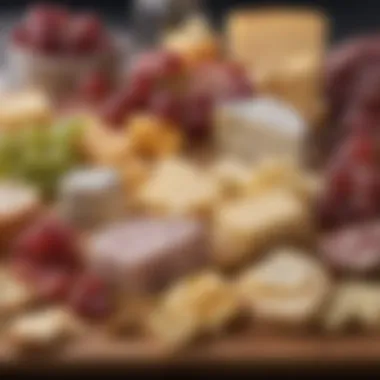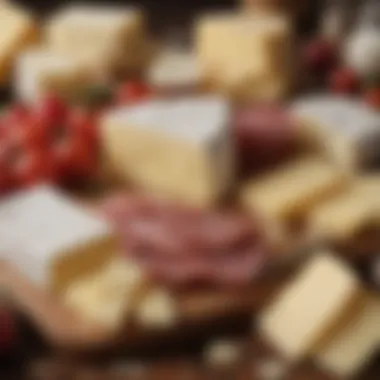Mastering Cheese Selection for Charcuterie Boards


Intro
Charcuterie boards have become a staple at gatherings and events, showcasing a blend of flavors and artistry. Cheese is often a significant component of these boards, serving not only to provide taste contrasts but also to enhance the visual appeal. This article aims to highlight the essential aspects of selecting cheeses for charcuterie boards, covering various textures, flavors, and pairing options crucial for creating a memorable experience.
Understanding the fundamentals of cheese selection will elevate your charcuterie game, whether you are a seasoned host or a novice. We explore different cheese types, the importance of serving techniques, and how to combine flavors to captivate your guests' palates.
This guide is more than just a collection of tips; it intends to impart a holistic view of cheese in the context of charcuterie boards. As we delve deeper into each segment, you will find insights that will inspire creativity in your culinary endeavors while ensuring an enjoyable presentation.
By the end of this exploration, you should feel equipped to craft a charcuterie board that not only satisfies but also impresses, embracing the rich world of cheese selections.
Intro to Charcuterie Boards
In the realm of culinary arts, charcuterie boards represent a significant element for gatherings and dining experiences. They provide not just sustenance, but an opportunity for creativity and expression. This section sheds light on the essentials of charcuterie boards, emphasizing their importance and the integral role cheese plays within them. Understanding charcuterie starts with grasping its essence, and this comprehension enhances the preparation and appreciation of the boards.
Defining Charcuterie
Charcuterie refers to the art of preparing and assembling cured meats and various accompaniments. Historically rooted in French cuisine, it extends beyond just meats to include a variety of items combined to create an enticing experience. While the term may seem straightforward, the practice involves a rich tradition, involving selection, presentation, and knowledge of flavors. It can include salami, prosciutto, or pâté, often paired with items like olives, pickles, and, critically, cheeses.
Charcuterie conveys a communal dining style. It encourages conversation and engagement among diners. This makes it an ideal choice for social occasions, improving the overall dining experience by evoking a sense of sharing and enjoyment.
The Role of Cheese
Cheese serves as a vital component of charcuterie boards. Its variety enhances both the visual and palatable aspects of the board. Offering a wide range of textures and flavors, cheese allows for extensive customization according to personal tastes and dietary preferences. The additions of cheeses like Brie, Gruyère, or Roquefort can elevate plain meats or snacks into a gourmet experience.
The role of cheese is not limited to mere flavor. It also complements other pairing elements effectively. Sweet fruits, crunchy nuts, and robust meats create a balanced profile when paired with various cheeses. This interplay of flavors is a reason whey cheese is indispensable to an exceptional charcuterie board.
Cheese not only enhances flavor but also serves as a visual centerpiece, making the charcuterie board aesthetically pleasing.
Types of Cheese for Charcuterie Boards
The selection of cheese is crucial when assembling a charcuterie board. Cheese not only adds flavor but also enhances the visual appeal of the presentation. The variety of cheese offers distinct tastes and textures, making the board more exciting. Each type of cheese serves different purposes and complements other elements, such as meats and accompaniments. Knowing the characteristics and benefits of various cheese types helps in creating a well-balanced and enjoyable experience for everyone.
Soft Cheeses
Brie
Brie is a classic soft cheese known for its creamy texture and mild flavor. Its rich taste and smooth consistency make it an excellent addition to any charcuterie board. Brie can be served at room temperature, enhancing its softness and appeal. Its mildness allows it to pair well with both sweet and savory accompaniments. However, it might not satisfy those who prefer stronger flavors. Nevertheless, its presence on the board invites exploration and balance with more robust selections.
Camembert
Camembert shares similarities with Brie but offers a distinctly earthy aroma and taste. This cheese features a delicate, bloomy rind that adds an interesting textural contrast. It is often enjoyed warm, which intensifies its flavor and creaminess. Camembert’s depth makes it a popular choice for charcuterie boards. However, its stronger taste can polarize opinions; while some delight in its boldness, others may find it overwhelming alongside milder selections.
Chevre
Chevre, or goat cheese, presents a tangy flavor profile that sets it apart from cow's milk cheeses. Its crumbly texture and bright taste can rejuvenate the palate. Chevre is especially appealing when paired with fruits, honey, or herbs. It adds a refreshing element to the board. However, its flavor can be quite strong for some, requiring mindful pairing. Thus, it works best in moderation and with accompaniments that can soften its sharpness.
Semi-Hard Cheeses
Gruyère
Gruyère is a Swiss cheese renowned for its complex and nutty flavor. This semi-hard cheese melts beautifully, making it versatile for both boards and cooking. It enriches the board, offering a contrast to softer cheeses. The flavor can vary depending on aging, which adds allure for cheese enthusiasts. Gruyère can be rather rich, so using it alongside lighter options ensures a balanced tasting experience.
Comté


Comté stands out with its sweet, caramel-like taste and firm texture. This French cheese presents layers of flavor that develop with age, making it a fascinating choice for charcuterie boards. Its nuttiness pairs well with a variety of accompaniments. While Comté’s versatility is appealing, its texture may not suit everyone’s preferences, especially if they favor creamier options. Nonetheless, it adds depth and character when included.
Asiago
Asiago is an Italian cheese that varies in texture based on its aging. Young Asiago offers a mild flavor, while aged Asiago becomes sharper and crumbly. This diversity allows it to fit into various charcuterie setups, catering to different tastes. It brings an enjoyable complexity to the board. A potential downside is that its more robust versions might overshadow softer, gentler cheeses, requiring careful balance in selection.
Hard Cheeses
Parmesan
Parmesan is an iconic hard cheese recognized for its granular texture and bold, savory flavor. This cheese works well crumbled over dishes or thinly shaved on a charcuterie board. Its saltiness can lift the overall taste profile of the board. Despite its popularity, Parmesan can be considered one-dimensional if overused. Thus, it is best used in conjunction with cheeses offering distinct flavors to maintain interest.
Pecorino Romano
Pecorino Romano provides a sharp and salty kick due to its sheep's milk base. Its powerful flavor can be a striking contrast to milder cheeses. This cheese is especially enjoyable with fruits or jams that can soften its intensity. However, its strong taste may not appeal to everyone. Therefore, it requires cautious pairing with complementary items to ensure an enjoyable experience.
Aged Gouda
Aged Gouda is celebrated for its sweet, caramel notes and crunchy texture due to the formation of protein crystals. This cheese offers a delightful balance between sweetness and savory depth. With its rich flavor, Aged Gouda enhances the charcuterie experience. That said, its distinct profile can overpower more subtle cheeses, necessitating a strategic approach when assembling the board.
Blue Cheeses
Roquefort
Roquefort is an esteemed blue cheese with a creamy texture and bold flavor profile. Its distinctively tangy and salty taste makes it an appealing choice. The marbling characteristic of Roquefort can bring visual intrigue to any board. However, its powerful flavor can be divisive. When serving, pairing it with sweet elements like figs or honey can balance its intensity, turning it into a harmonious addition.
Gorgonzola
Gorgonzola is another versatile blue cheese, offering both sweet and savory notes. It can be creamy or crumbly depending on the variety. This adaptability allows it to fit into different culinary contexts. When incorporating Gorgonzola into a charcuterie board, its rich flavor may require balance with other cheese types. However, its diverse pairings can create a memorable tasting journey.
Stilton
Stilton is a rich and crumbly blue cheese known for its complex flavor profile. Its creamy texture and mild sweetness can attract even those hesitant about blue cheeses. Stilton’s flavor can evolve, providing an engaging tasting experience. However, it may not be as accessible for everyone. Thus, it should be placed alongside complementary cheese to accommodate a variety of palates.
Choosing the right cheese type is a critical aspect of crafting an exceptional charcuterie board. Understanding the nuances of each variety enhances overall flavor and presentation.
Factors to Consider When Selecting Cheese
Choosing the right cheese for a charcuterie board is crucial. The quality of cheese determines the overall experience. Various factors affect cheese selection, such as texture, flavor, and origin. A well-thought-out selection ensures an enjoyable mix that appeals to many palates. Each factor contributes to the balance of taste and presentation. Therefore, understanding these elements enhances appreciation.
Texture
Texture can vastly influence how cheese is experienced. Soft cheeses provide a creamy mouthfeel, which contrasts nicely with sturdy meats. Semi-hard and hard cheeses offer a firmer bite, adding depth to the board. A good mix of textures makes the board interesting. Cheeses like Brie and Gruyère can be paired effectively for this purpose. Selecting cheese with varying textures creates a harmonious eating experience.
Flavor Profile
The flavor profile of cheese is essential. Different profiles can play into the overall scheme of the board. Here are three primary categories of flavor:
Mild
Mild cheeses, such as mozzarella, are often soft and provide a subtle taste. Their mildness allows them to blend well with stronger flavors without overshadowing them. This feature makes them an appealing choice. They do not intimidate even the less adventurous diners. Their versatility offers various pairing options for different meats and accompaniments.
Savory
Savory cheeses, like aged cheddar, invite deeper taste. They carry complex flavors that enhance the charcuterie experience. The richness can complement salty meats quite well. The key characteristic of savory cheese is its ability to stand out while still being harmonious with the other elements on the board. It can attract more cultured palates, leading to satisfying experiences.


Spicy
Spicy cheeses bring excitement to the plate. Varieties such as pepper jack provide heat that can elevate simple bites. This characteristic adds a unique twist, making the board dynamic. However, their strong profile may not suit every guest. It's essential to provide a balance with milder options to satisfy everyone’s taste.
Origin and Variety
The origin of cheese often signifies its quality and uniqueness. Cheeses from specific regions reflect traditional methods and flavors. For instance, Parmigiano-Reggiano comes strictly from certain areas of Italy. Understanding different cheese varieties allows for better pairing with wines and meats. Choosing cheeses based on origin can elevate the charcuterie experience significantly. Each region’s unique cheese tells a story, making the board not only a feast but also a discussion starter.
Complementary Pairings
Complementary pairings are fundamental in assembling a charcuterie board. They elevate the experience by creating a harmonious balance of flavors, textures, and visual appeal. Cheese, though a star ingredient, interacts with various accompaniments, which enhance both taste and aesthetics. Successful pairings can turn a simple selection into a memorable culinary voyage.
Charcuterie Meat Selection
Charcuterie meats such as prosciutto, salami, and chorizo amplify the flavors of cheese. These meats offer a savory richness that contrasts with the creaminess of cheeses. For instance, the saltiness of prosciutto can elevate the mildness of Brie. When considering meat selections, think about the fat content and spice levels; they can significantly influence how well they blend with specific cheeses.
Accompaniments: Fruits and Nuts
Fresh Fruits
Fresh fruits bring brightness and a juicy element to the board. Fruits like figs, grapes, and apples serve not only as palate cleansers but also as contrasting flavors to the creaminess of cheeses. The sweet and tart nature of these fruits complements the savory taste, which is crucial for an engaging charcuterie board. Moreover, fresh fruits are refreshing and can help balance heavier flavors found in aged cheeses.
Dried Fruits
Dried fruits such as apricots, cranberries, and dates add concentrated sweetness and chewiness, which contrasts nicely with the crispness of crackers. Their shelf-stability is a notable advantage, allowing for long-term inclusion in charcuterie boards. However, it's important to choose varieties that do not overpower the delicate flavors of cheese. The unique chewy texture can be both a benefit and a drawback, depending on the overall composition of the board.
Nuts
Nuts provide a necessary crunch to the charcuterie board. Almonds, walnuts, and pecans introduce earthy notes which complement the richness of cheese. They also contribute to the texture profile, offering a satisfying contrast with soft and semi-hard cheeses. Keep in mind that nuts can vary in flavor based on whether they are salted or raw, which should be considered when selecting for specific pairings.
Breads and Crackers
Breads and crackers serve as a base for cheese and accompaniments. Baguette slices, crispbread, and artisan crackers can influence the overall experience. They provide the necessary vehicle for sampling various combinations of cheese and other ingredients. Selecting varied types ensures a balance between soft, crunchy, and dense textures, enhancing the enjoyment of the charcuterie board.
The synergy created by thoughtfully selected pairings can make a charcuterie board not just a meal but an experience.
Crafting the Perfect Board
Crafting the perfect charcuterie board involves more than just placing items together. It represents a culinary composition where careful consideration of elements leads to a harmonious experience. This section highlights the importance of layout, visual appeal, and flavor balance, all of which contribute to an impressive presentation. Achieving this requires not only understanding the individual components but also how they interact and complement each other.
Arrangement Techniques
The arrangement of cheese on a charcuterie board is a critical factor in its overall appeal. Effective arrangement involves grouping items in a way that feels inviting yet organized. One common method is to use a circular pattern, placing larger cheeses in the center while surrounding them with smaller items. This approach creates a natural flow and encourages sharing.
Additionally, variations in height can enhance visual interest. Using cheese knives or small dishes can help elevate some cheeses. It’s recommended to alternate colors and textures to create a vibrant and enticing appearance. Avoid overcrowding, as space provides breathing room, allowing each cheese to shine.
Visual Presentation
Visual presentation significantly impacts the enjoyment of a charcuterie board. A well-crafted board can stimulate appetite and curiosity, encouraging guests to dive in. Color plays an essential role in visuals. It is beneficial to select a range of cheeses that vary in hue, from the ivory of Brie to the blue veining of Roquefort. This not only provides eye-catching contrast but also signals variety and richness in flavors.
Moreover, incorporating garnishes like herbs or edible flowers can elevate the aesthetic. These additions add freshness and intrigue, turning a simple board into an artistic display. Pay attention to ensure all items are accessible while maintaining an organized appearance.
Balancing Flavors and Textures
Balancing flavors and textures is vital for a well-rounded experience. It is essential to include a mix of mild, savory, and pungent cheeses. For example, a smooth Brie can offset the bold taste of a tangy Gorgonzola, creating a contrast that enhances the palate. Each cheese should offer a distinct flavor while harmonizing with others on the board.


Textural variety also plays a key role. Soft cheeses like Chevre provide creaminess, while hard cheeses like Parmigiano-Reggiano offer a satisfying crunch when aged. The mix of textures creates a multisensory experience that resonates with diners. Thoughtfully selecting each cheese reduces monotony, ensuring your charcuterie board remains both exciting and satisfying.
„A memorable charcuterie board engages the senses and invites exploration. Careful crafting reflects thoughtfulness and creativity in your hosting.
Serving Suggestions
The way cheese is presented can significantly impact the overall charcuterie board experience. Serving suggestions cover various elements like temperature, how the cheese interacts with the other components of the board, and the choice between using a board versus a plate. Each of these factors plays a crucial role in enhancing the flavor, texture, and visual appeal of the cheese and the board as a whole. Understanding these suggestions ensures that one can elevate the simple act of serving cheese into an art form.
Optimal Temperature for Cheese
Cheese is best enjoyed at the right temperature. Serving cheese at room temperature allows the flavors to expand and become more pronounced. Each type of cheese has an optimal temperature range that brings out its unique profile. Generally, this means removing cheese from the refrigerator at least 30 minutes before serving. For example, creamy cheeses like Brie or Camembert should be served slightly warmer than colder varieties like aged Gouda.
It is observed that when cheese is too cold, it can taste bland. The fats in the cheese need warmth to release their flavors. Thus, temperature management is essential for achieving the full aroma and taste profile of the cheeses on your board.
Board Versus Plate Service
When it comes to presentation, deciding between a board and a plate can influence the overall dining experience. A wooden or slate board allows for a visually appealing arrangement and adds a rustic touch. It also offers more space for various cheeses and accompaniments. This method encourages communal sharing, making it ideal for gatherings.
On the other hand, serving cheese on individual plates may provide a more refined dining experience. This method allows personalization, where guests can have their own portions, potentially reducing the spread of germs. However, individual plates can limit the assortment of cheeses and accompaniments that can be displayed.
Quote>>
"Both board and plate service have their advantages, but ultimately the choice should align with the occasion and the ambiance desired."
Cheese Storage Techniques
Proper cheese storage is crucial to maintaining the quality and flavors that charcuterie board cheeses possess. The way cheese is stored greatly affects its lifespan and taste. Cheese is a living food; it can age and change flavor over time. Hence, understanding the specific storage techniques is essential for anyone dedicated to enjoying or serving cheese.
Short-Term Storage
Short-term storage focuses on cheeses intended for immediate consumption. When cheese is kept for a few days or up to a week, the following methods can be applied to ensure freshness:
- Wrap in Paper: Use specialized cheese paper or wax paper to allow the cheese to breathe while preventing it from drying out. This method preserves moisture and flavor.
- Place in a Container: A breathable container helps maintain humidity. Avoid plastic wraps as they trap moisture, potentially leading to mold growth.
- Store in the Fridge: The ideal refrigerator temperature is between 34°F to 38°F. This keeps cheese cool without freezing, which can alter its texture. Always place cheese in the vegetable crisper where humidity is higher.
By closely monitoring cheese during short-term storage, one can enjoy the intended aromas and textures that make charcuterie boards appealing.
Long-Term Storage
Long-term storage applies to larger cheese quantities or those not consumed quickly. If proper techniques are not applied, flavors can diminish, and spoilage can occur. The fundamental aspects include:
- Vacuum Sealing: This technique removes air, significantly slowing down bacterial growth. It’s best for semi-hard and hard cheeses, such as Gruyère or Parmesan. Just ensure to rewrap in appropriate material once opened.
- Freezing: Although not ideal for all cheeses, certain types can be frozen for extended periods. Soft cheeses don’t freeze well due to textural changes. However, hard cheeses can be wrapped tightly in freezer-safe bags. Remember that thawed cheese may be crumbly but still usable in cooking.
- Monitoring Temperature and Humidity: Cheese thrives in specific conditions. A controlled temperature of 32°F to 34°F is optimal for long-term storage. Additionally, a humidity level of around 80% is beneficial for retaining flavors and preventing excessive drying.
Proper cheese storage is not just about preservation; it’s about extending its life while maintaining quality and taste.
Following these guidelines can lead to a better cheese experience on your charcuterie board, pleasing both the palate and the eye.
End
The conclusion serves as a critical component of this article, encapsulating ideas about cheese selection for charcuterie boards. This section aims to synthesize the knowledge gained throughout the text, highlighting the various aspects involved in creating an exquisite charcuterie experience. The importance of thoughtful cheese selection is emphasized, showcasing how the right choices can elevate flavor, aesthetics, and overall enjoyment.
When one curates a charcuterie board, the cheese plays a key role. The interplay between different textures and flavors contributes significantly to the palate experience. Understanding the nuances of soft, semi-hard, hard, and blue cheeses creates an appreciation for crafting a harmonious board.
Additionally, storage techniques are essential to maintain cheese quality, ensuring it remains fresh and flavorful before serving. Proper handling not only enhances taste but also preserves the integrity of the presentation. A well-stored cheese maintains its character, thus enhancing the enthusiasm of food lovers.
As food enthusiasts select cheese for their boards, they must consider various pairings and complementary foods. Meats, fruits, nuts, and crackers enrich the overall composition. The thoughtful pairing maximizes flavor, inviting guests to explore the delightful textures and tastes.
In summary, the conclusion underlines that creating an exceptional charcuterie experience goes beyond simply placing cheese on a board. It encompasses an understanding of types, qualities, and thoughtful pairing, ultimately resulting in a memorable culinary journey. Those embarking on this endeavor benefit not just from knowledge but also from the creativity involved in crafting a board that reflects personal taste and culinary curiosity.
Final Thoughts on Cheese and Charcuterie
In reflecting on the practice of assembling a charcuterie board, it is clear that cheese selection demands a careful approach. The diverse range of cheeses allows for creativity and personalization, which can be a true delight for any gathering.
With rich histories behind each cheese, from Brie to Roquefort, there is much to discover and appreciate. Each selection speaks to the chef’s personal preferences, presenting guests with a curated experience. This emphasis on thoughtful selection should not be underestimated. It's an opportunity to share not just delightful foods but also knowledge and stories around each type.
Ultimately, cheese is more than just a component of a meal; it plays a pivotal role in social dining experiences. By focusing on quality and variety, everyone can transform a simple gathering into an extraordinary culinary experience.















